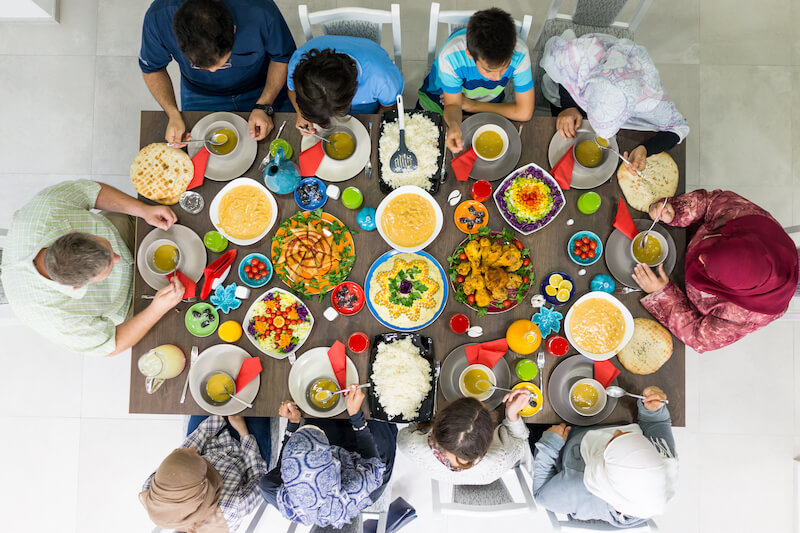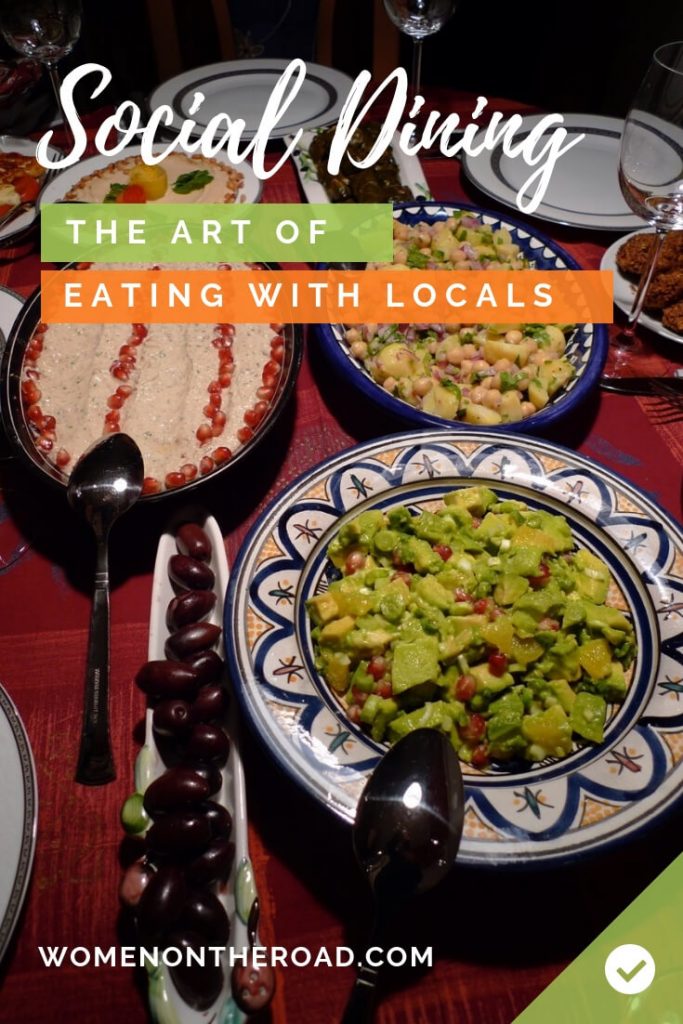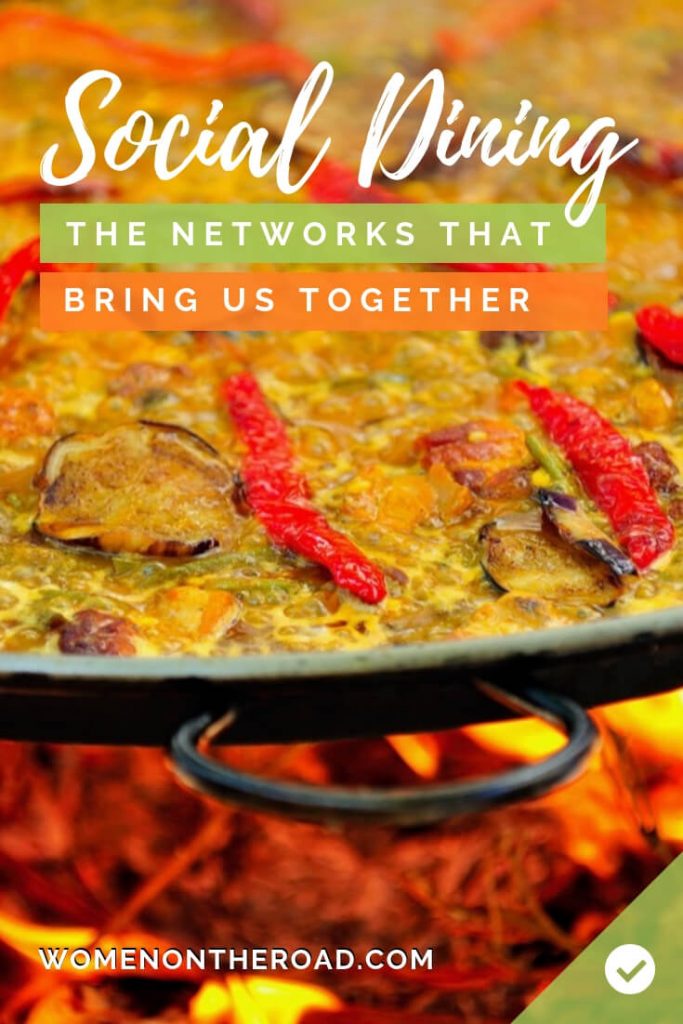Solo travel is wonderful but – don’t you sometimes wish you could share a meal and have a conversation with someone?
What if (like many of us) you’re too shy to just walk up to people you don’t know and strike up a conversation?

Eating alone can be fun but… maybe not every single day.
Yet many of us travel because we want to experience local culture, eat local food and meet local people.
What better way to do this than by being a guest in someone’s home?
There’s Airbnb for rooms and Uber for rides, but a plethora of social networks have made inroads into that most hallowed of halls: the dining room.
I’m talking about social dining, or eating with locals.

Most of these networks function along similar lines: you choose your city or destination, pick a host family or activity, book online, message back and forth if needed, and pay, either through the website or PayPal.
The experience is usually straightforward – you go to someone’s home and they cook for you.
At times, though, hosts like to take whimsical approaches to hosting – they can turn their dinners into themed events, hold them at an unusual venue, or focus on certain types of food, like tapas or chocolate.
The most popular social dining networks
Eat With
Eat With is probably the largest and most sophisticated social dining network in the world, with 150,000 members in more than 130 countries. It’s an easy-to-navigate site with plenty of filters to make sure you pick the dining experience that’s right for you. What I liked: Clickable food photographs organized by destination. Caught my eye: The So French Apero. I mean, who doesn’t want to enjoy a proper French apéro? (You can read all about apéro time here.)
BonAppetour
Well established in Europe, BonAppetour has a strong presence in Asia. What I liked: Global, site in lots of languages. Hosts are verified. You get 20% off your first experience. You can buy gift cards for friends and family. 24/7 support – you never know!
Another global network is Traveling Spoon, and you’ll also find local networks dedicated to a region or a country, like Cesarine for Italian regional cuisine or Eat at a Local’s, which focuses on Portugal.

The etiquette of social dining
Heading off to someone’s home for a meal?
There are certain rules – most of them unwritten – that you should consider following. Even if you’re paying for the experience, you ARE going into someone’s home.
- Make sure you’ve warned your host of any allergies.
- Of course, arrive on time for dinner.
- It’s nice to bring a little something with you – some chocolate or a little entertaining gift – nothing fancy.
- A few compliments about the home or the table setting will bring the host some joy, especially when pre-dinner nerves are at work.
- During dinner, take part in the conversation. Listen, contribute but don’t monopolize. Remember it’s not just about the food – you can go to a restaurant for that. Don’t be shy to ask questions about what you’re eating and the stories behind the food.
- Be careful with alcohol. If it’s consumed, don’t go overboard. If it isn’t on the menu, don’t insist. It may not be culturally acceptable for your host.
- Leave when it’s time to leave. You may be just settling in, but for your host it might be bedtime.
- Don’t forget to write an honest review after you’ve gone.

Things to think about for your ‘eat with locals’ night out
- Arrange your transport there and back. Where is your host’s home? Is it in a faraway neighborhood? If so, make sure you can find a safe ride back – reserve a cab or Uber before you go or ask if they can handle that for you.
- If you’re traveling solo, can you be the only guest? It depends. Some hosts are fine with a single guest, others need at least two people to organize dinner. Ask them – another solo traveler may be trying to book and both of you together means dinner is on (not to mention the fun of meeting another traveler!)
- Will you fit in? What will the other guests be like? Well, you can’t predict everything in life so go on, be surprised. Take your open mind to dinner.
- Should you book your social dining experience at the beginning or at the end of your stay? At the beginning, your hosts might give you some good local pointers about what to see and do. At the end, you’ll have a nice send-off before you leave. Your call!
- What to wear? No problem. Wear what you would wear to a casual restaurant.
- What about hygiene? Restaurants must meet certain legal standards but no one is checking your host’s home. Your host is probably receiving you because s/he loves to cook and is house-proud. A bad review from you would damage the host’s reputation so s/he has every incentive to please you. I’d trust that.
- What if your plans change? Most networks have some sort of cancellation policy but beware, preparing a meal may take a few days if rare ingredients are needed and once those preparations have started, it’s neither fair nor polite to try to wiggle out of a commitment.
Social dining – reader experiences
Not everyone uses a service or a network to arrange meals with locals on their travels. Sometimes, things just happen.
I asked Women on the Road about their own experiences and advice in eating with locals, and here’s what they shared.
Bev from Auckland
A meal I had recently was with my Airbnb host in Lisbon. I arrived as my host was in the midst of a dinner party. Without hesitation, she invited me to join them and poured me a glass of red wine. I had just arrived in the country and couldn’t have felt more welcomed.
Kristina from Michigan
Just make sure there are at least two other couples/3-4 people in the event the experience is very awkward and uncomfortable.
Kathy Francis from Charleston, South Carolina
I have had home-hosted dinners on trips to Ecuador and Thailand in which the family prepares the meal and we meet them in their home. It’s always an open and friendly evening, with both cultures wanting to learn from one another.
Philippa from Portugal
I have used social eating networks many times to have dinner with local people everywhere I travel! It was a really fun way to meet local or just regular people who are living for some time in a country and bonding as if you had friends everywhere you go. And… I really recommend it!
Monique Peubez from the Jura, France
On a trip to the Faroe Islands, while speaking with a local student outside a church her mum opened a window and told her daughter to invite me for dinner. They offered me dry whale meat and mutton! Such a lovely family… since I had some French cheese still left in my rucksack I offered them some International friendship.
Anne Betts from Packing Light Travel
I love the way the sharing economy is transforming the way we travel, and how it promotes interaction with locals. I booked a delicious seafood dinner hosted by a grandmother and her granddaughter in Barcelona – I loved being welcomed in a Catalan home, the conversation, observing the interaction between a devoted granddaughter and her grandmother, the distance from the “tourist trail” and enjoying a home-cooked Catalan specialty.
Faith Dugan
I’ve had a few wonderful experiences I’ve loved – once I was invited to the owner’s home of an apartment I was renting. I had only communicated with her by email. It was a lovely evening filled with wonderful conversations with her and her husband.
Donna Armer, Beaufort, South Carolina
I book places to stay before I leave the US. I’m able to correspond with the owner before I arrive. Once I’m sure the place is right for me, I ask the owner for help in finding local people who are willing to teach me to make bread or pasta or any local specialty. These exchanges develop a foundation for a friendship even before I arrive.
Coby Sikkens, Valleiry, France
In Tokyo, where I was for a meeting, some of my Japanese colleagues invited me to their home for dinner. The food was delicious, but I was wearing my office business two-piece suit and sat on the floor behind a low table. As I was unable to sit the way the Japanese did with my legs folded under me, I was allowed to stick them under the low table where they almost showed at the other end. After dinner, I was rescued by someone who found a chair!
Monica Murphy
One meal that comes to mind is a lunch I had at a friend’s house in Oman. As with most activities in their daily lives, the men and women eat their meals separately, but I found myself eating in another house, sitting on the floor with the men and taking food from the communal serving dish. The Omanis are very polite and hospitable, and this would be “haram” (forbidden) in their culture but I can think of two reasons for this. First, someone asked if I was hungry and I said I was, because in Arab culture lunch is served later. Perhaps the ladies’ meal hadn’t been prepared yet. The other reason may have been language. My friend’s brother spoke good English while the women could not. We had Biryani chicken, originally from India, a dish a lot of Omanis have for every meal!

— Originally published on 09 November 2016
SHOP THIS POST ON AMAZON
PIN THESE PICTURES AND SAVE FOR LATER!







